[FONT=Times][SIZE=5]
My Valve Gear Simulation Software
First I have to say Thank You to Ronald Fossum. Without his help the English speaking world would have to wait for this English program version many years - and - I would be never ever be able to translate it in this excellent way.
Originally I wanted a quick way to calculate the valve gear action for my “Arkona” steam boat engine. Then I added a “Visualization” subroutine to the program. Pictures and diagrams not only add clarity but – particularly if they’re moving – also increase interest in the function and performance of steam machinery.
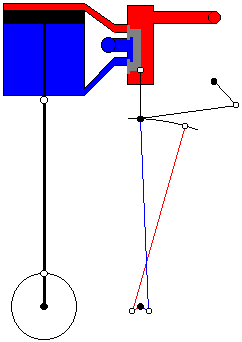
Insertion of engine particulars (length, radius, pressure, etc.) is done through the individual windows. The basic unit of length or volume measurement throughout the American translation of this program is the inch (You can change to mm whenever you want). I and the program set up the appropriate geometrical mathematics. Below is a typical “input” window.
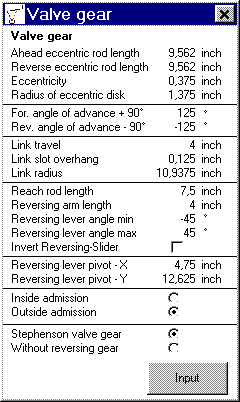
In the Main Window (seen below) are controls which immediately affect the computations and influence the valve gear simulation. This is, as it were, the control station of the engine. This is where certain data computations are displayed in counters or registers. If you want to watch the reversing lever moving see this Animated Gif
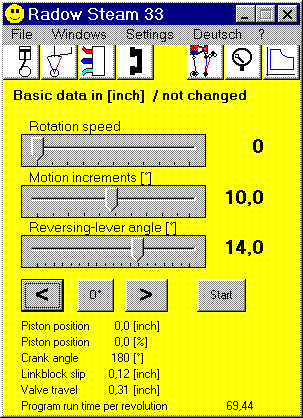
This graph window (one of three for valve movement) shows valve movement by angle of crank (0° is taken at 12 o’clock and the degrees are numbered in a clockwise rotation. In America, direction of rotation in marine engines is as viewed from the after end of the engine, but you will have to look at the geometry of the engine–location of reversing lever, movement of link, etc.–to decide if this is right for you.).
The four heavy horizontal black lines represent the edges of the valve face ports. The upper two represent the port/passage at the top of the cylinder and the bottom two, at the bottom of the cylinder.
The sine curves represent the position of the valve edges. Through these sine curves one can easily see the amount a valve port is open at any crank position. The red area represents steam admission and the blue, steam exhaust.
Here you can see, graphically, the resultant changes in steam flow – and therefore engine performance – caused by variations in valve gear geometry, angle of advance, and valve lap.
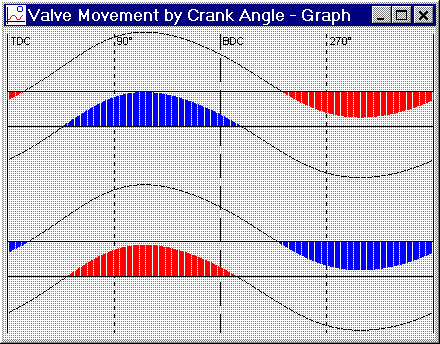
The values and the card are theoretical only. The actual (working) values are affected by many factors including (but, certainly, not limited to) the size of the engine. For example, if an engine is very small (like a model steamship engine) the proportionally large steam passages necessary for the model to work create clearance volumes well beyond acceptable practice.
However, the program calculated values given here, as well as the theoretical card, are a good starting point.
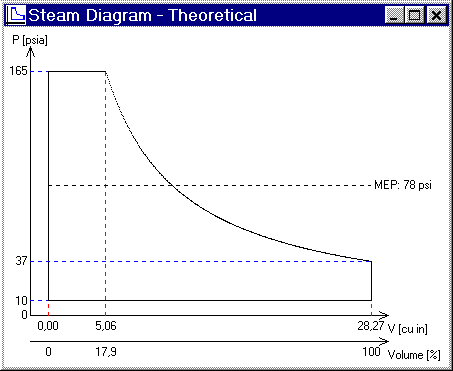
In the window Operating Parameters one inserts information about the pressures of the steam supplied to the engine – and thereby directly affects the Steam Diagram. Here you will find all the information about steam consumption and output power of your engine.
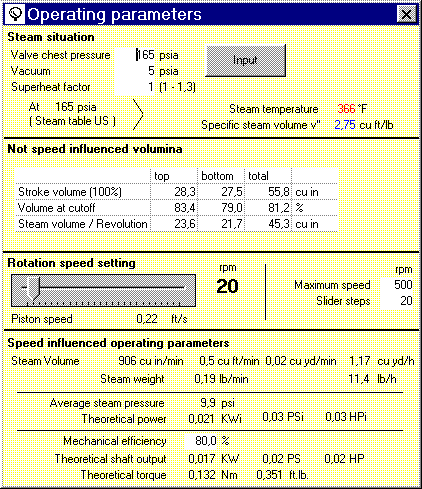
If you like, you can download a free copy of the program here.
Just click on the two files with the right mouse button (on Windows Systems) and download them to any directory in your computer for free. After that click on the dampf15e.hlp file and it will start automatically.
dampf15e.hlp ca. 51 kB
dampf15e.cnt[B] ca. 2 kB
[/b]
[/size][/font]